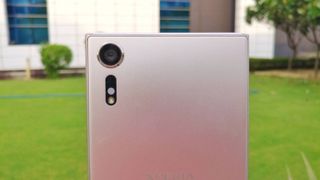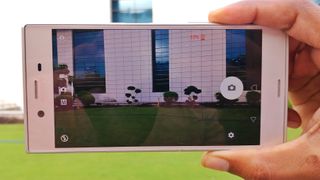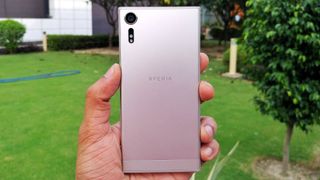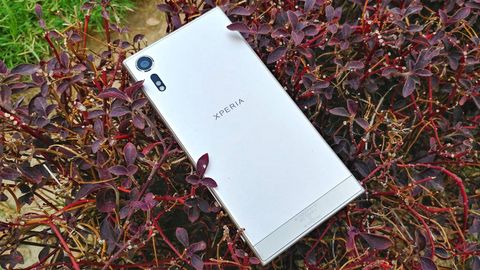TechRadar Verdict
Xperia XZs feels like a complete smartphone but comes at a price where there are many compelling options to go for. If you are looking for an major upgrade in the Xperia lineup, wait for the XZ Premium.
Pros
- +
Great build quality
- +
Neat UI with Android Nougat
- +
Punchy display
- +
Comfortable to use with one hand
- +
MicroSD support
Cons
- -
Dull loudspeaker
- -
High price
- -
Thick bezels on top and bottom
Why you can trust TechRadar
Design 4/5
Features 4.5/5
Performance 3.5/5
Usability 4/5
Value 3.5/5
Sony announced four smartphones at this year’s MWC including an upgraded version of last year's flagship Xperia XZ. Without much delay the company announced the Xperia XZs in India earlier this month.
While the Xperia XZ had everything to mark itself as a true flagship, the smartphone was overlooked over its competitors which existed in the market from a longer time. The XZs comes with mandatory upgrades that were somewhat missing in its predecessor but most other features are identical in both the handsets.
The highlight of the XZs is its camera, thanks to the new Motion Eye camera system. Priced at Rs 49,990 the smartphone looks like a complete package, but are these changes good enough to make it worth your money? Find this out in our review.
Design
The Xperia XZs when compared to its predecessor shows no sign of upgrades. The design and build remains what Sony calls the leap design, with rounded sides that melts towards front and back for a comfortable in hand feel. Unlike most other smartphones, the Xperia XZs has a flat top and bottom sides, which allows it to stand on a flat surface.

No doubt about Sony’s design perfection but in this case, it has to be highlighted that most other companies are moving to a bezel-less design, the XZs still has thick bezels on the top and bottom. Other than this, the phone feels good in hand, easily usable with one hand, finish is top-notch and feels solid. There are very few phones which look good in all colour variants, and this is one of them. The minimalistic back panel with rich yet subtle finish is something that takes the feel a notch higher.
It comes with a metal plate on the back with polycarbonate on the sides, and curved glass on the front. The 3.5mm audio jack is on the top and USB Type-C port is at the bottom. The loudspeaker is on the front, and the power button, volume rocker, and a dedicated camera shutter button are on the ride side. One more thing that feels odd is the placement of volume rocker, although, it helps while zooming in and out in viewfinder while holding it in horizontal position to click a picture.
Display
Like the design, the XZs also retains the 5.2-inch full HD display panel with a pixel density of 424ppi. In day to day usage, the display is very vibrant, sharp and can be viewed from extreme angles. The colour reproduction is excellent, and even the sunlight legibility is on point.

Overall, I have no complains from the display department in terms of quality, but yes, it does not offer you any feature like always on display. The 1080p resolution looks less on paper but I didn’t feel it affecting the experience in any way.
Camera
Talking of the upgrades, camera is the biggest change in Xperia XZs over its predecessor. It comes with a 19MP Motion Eye camera on the rear over 23MP sensor on the XZ, but we know megapixels do not effect the image quality primarily. This time around, Sony has increased the pixel size to attain a better camera performance in low-light.

Sony has kept the dedicated the camera shutter button consistent in most of its smartphone, and photography enthusiasts embrace this feature. The predictive hybrid autofocus feature turns out to be an impresser when it comes to capturing moving objects.
The rear camera captures great colours, excellent dynamic range and good amount of details in pictures. It can let you click some breathtaking shots if you have ample of light to feed the sensor. Camera launches quickly, autofocus is quick and image processing snappy too.
In low-light, the camera has improved a lot, and it is one of the better performers in such conditions. You might see a drop in details but it is common with most other cameras. The best part is that the images in low-light look well balanced with right amount of light and exposure.
There is a 13MP front camera, and with high megapixel count comes the flexibility of zooming and cropping your pictures. It captures pleasant looking colours, plenty of details, and works well even in low light. I won’t rate it as the best selfie camera in its segment but it still gets the job done impressively.

Sony has been touting the 960 fps slow motion video capability of the phone, so I decided to put it at test. No doubt, you can make some incredibly amazing looking slow motion videos but it’s not as good as I expected it to be. The 960 fps videos are capped at 720p resolution, which brings in the cropping factor and that results in compromise with the video quality. Due to the high frame rate, it requires a lot of light around to work at its best.
Battery, connectivity
The Xperia XZs packs a 2900mAh battery unit which seems decent on paper and suffice most users. Light usage that involves browsing social media, texting, listening to music or reading news can easily get you a full day of usage, thanks to the Snapdragon 820 and Nougat features. Anything on the aggressive side like playing games, watching videos or doing a video call can cut down the backup by couple of hours.

The device also offers Qnovo adaptive charging on top of Quick Charge 3.0. With the bundled charger, the phone’s battery reached 40 percent charge in around half an hour.
During my experience, I did not notice any connectivity issue. WiFi, Bluetooth and NFC work well with most other devices I paired it with.
The fingerprint is very snappy and I really like the side placement compared to the ones on the back.
Performance
Apart from the camera, another major change in the XZs is the 4GB of RAM over the 3GB on XZ. The smartphone comes with a the same processing hardware as its predecessor, be it the Snapdragon 820 or the Adreno 530 GPU. I think Sony could have given a thought to deploy a better Snapdragon 821 to make it look better, at least on paper.
It may not have the latest processor but it is still good enough to take care of even the toughest of the tasks. I did not experience any issues in opening or closing of apps, multi-tasking, gaming or browsing heavily loaded web pages. There was no abnormal heating on the device but I did find it getting hot while recording 4K videos.
Software
The Xperia XZs comes with Android Nougat 7.1.1 out of the box with the latest version of Sony’s custom UI on top. In recent years, I have realised that Sony’s UI has become much cleaner, simpler and smooth, which combines to offer a pleasant software experience. Despite keeping it simple, Sony has very subtly keeps the like custom launcher, wallpapers, themes and Sony’s bloatware in the interface.
I personally prefer stock Android over custom skins, but there are few OEMs which have managed to tone down their UIs to perfection and Sony is one of them. It feels smooth and I hardly noticed any stutter in the animations or transitions.
Apart from the bloatware, there is nothing else on the software to complain about. The presence of Android Nougat packs in some extra features including the Google Assistant right out of the box.
Verdict
At Rs 49,990, the Xperia XZs competes against the likes of Galaxy S7 Edge, iPhone 7, Google Pixel and LG G6. Sony Xperia XZs is about a good build, good display and some innovative camera features for photography enthusiasts. In a market like India, it all comes down to the amount of value the smartphone offers, which certainly brings in the comparison.

Despite being a complete handset with tiniest of downsides, the XZs is not worth an upgrade from its predecessor. If you want a real upgrade over the Xperia XZ, it’s better to save your money for the Xperia XZ Premium.
Sudhanshu Singh have been working in tech journalism as a reporter, writer, editor, and reviewer for over 5 years. He has reviewed hundreds of products ranging across categories and have also written opinions, guides, feature articles, news, and analysis. Ditching the norm of armchair journalism in tech media, Sudhanshu dug deep into how emerging products and services affect actual users, and what marks they leave on our cultural landscape. His areas of expertise along with writing and editing include content strategy, daily operations, product and team management.

